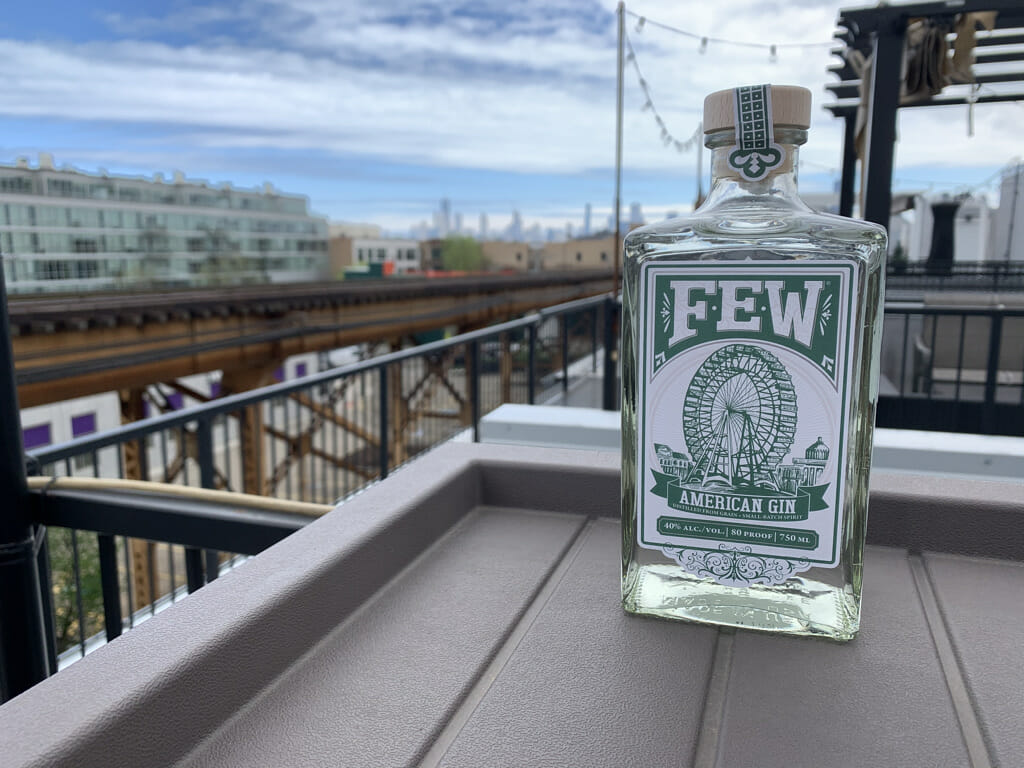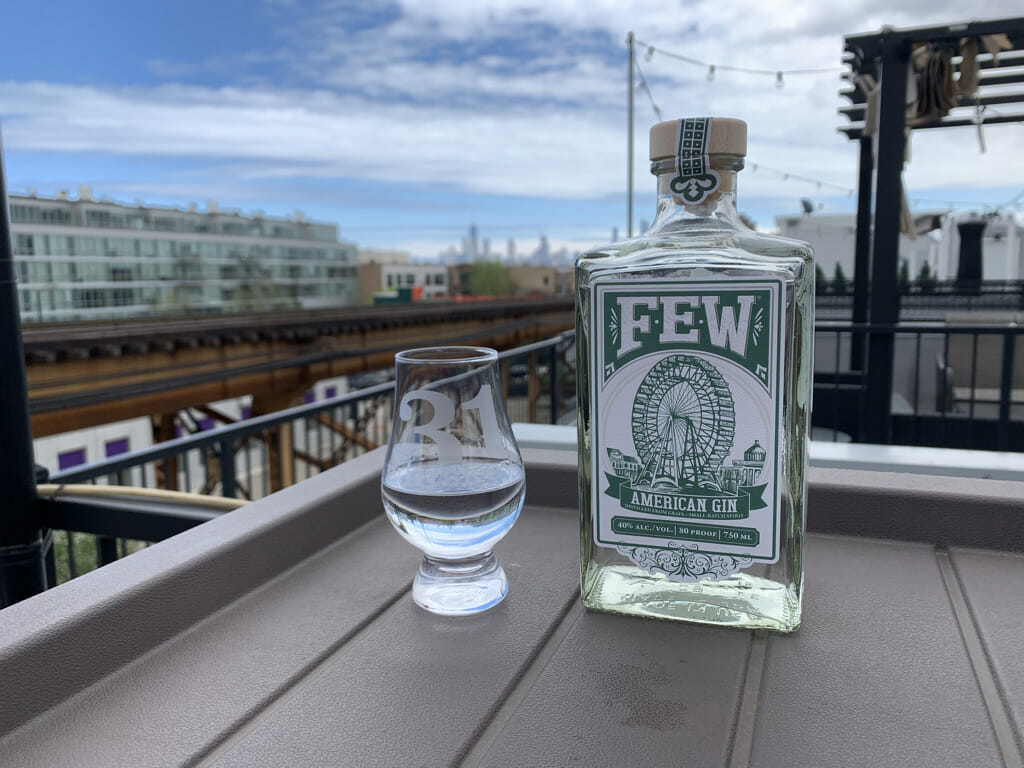
Previously here at Thirty One Whiskey, we reviewed the bourbon and rye whiskey from Few Spirits in the Chicago area. Few does more than whiskeys, though — they also produce several gin varieties with the same focus on local ingredients and craft distilling. Since we’re big fans of their bourbon, we were pretty excited to check out more of their offerings… and let’s just say, they didn’t disappoint.
Advertisment
History
Evanston, located just north of Chicago, was the birthplace of the temperance movement that spawned Prohibition in the United States. For nearly a century following the end of prohibition the city continued to maintain some of the most restrictive laws regarding the sale and consumption of spirits, but all of that started changing in 2001.
Paul Hletko didn’t start out in the distillery business. Engineer, patent attorney, and rock and roll band member, Paul took a rather unconventional route to the whiskey business. According to Paul, the biggest inspiration for his turn to distilled spirits came from his grandfather, who owned a large brewery in Poland prior to the outbreak of World War II. Paul’s grandfather was forced to flee the country and spent the rest of his life unsuccessfully fighting to get it back. That determination and love for alcoholic beverages was a family tradition Paul wanted to continue.
Between 2001 and 2011, Paul was instrumental in getting the laws changed in Evanston to allow for alcohol distribution and production to resume. The path now clear, he opened his very own distillery called Few Spirits dedicated to doing things right: in-house production using local ingredients.
Product
- Learn More: What Is Gin?
Few Spirits makes it very clear that this is an American style gin, which is a different take on the form than the more common London Dry or the hipster beloved Old Tom gin. From an interview on the matter, Paul himself had a few choice words to say:
“To me, American-style gin is just a gin that isn’t ‘dry’ with loads and loads of juniper,” says Paul Hletko, founder of FEW Spirits. “American gins, as a whole, differ from traditional London Dry by being what I call ‘wet,’ or perhaps sometimes ‘moist.’ Many [American producers] are choosing to work within a much ‘wetter’ style, featuring loads of floral, citrus, or some character other than juniper.”
While the word “moist” may be even more polarizing than the gin category itself, Hletko’s definition is generally accepted by his peers. Aaron Selya, master distiller of Bluecoat Gin at Philadelphia Distilling, agrees that “American-style gins place an emphasis on a flavor or botanical other than juniper.”
https://chilledmagazine.com/what-is-american-style-gin
Few Spirits’ American gin starts as a dry mix of 70% corn, 20% wheat, and 10% malted barley (which is a regional variety of barley). Interestingly, this is pretty much the same grain bill from their bourbon. That grain bill is fermented using a specific form of yeast that’s typically used in the production of saison beer (a typically lighter and crisper form of beer).
During production, this gin uses many botanical elements including juniper, lemon, vanilla, orange peel, and what is most likely a bitter hop. Those are all the components of a traditional gin, the difference that makes this an American gin is the proportion in which they are each used. (And with the juniper, the word there is “sparingly”.)
Packaging
It feels like the bottle is designed to pair perfectly with the classic Chicago skyline. It’s neo-gothic structures that bring you straight back to the turn of the century Chicago and the front is adorned with the “Chicago Wheel”, the original Ferris wheel built for the 1892 World’s Columbian Exposition.
The bottle is rectangular with flat sides, a sharply tapering shoulder, and a short neck. On the front and back of the bottle are full size labels in the same style of the 1890’s, with monotone green printing and old fashioned type face. The label isn’t too busy or overstated — instead, it has just enough artwork to make it an interesting look at Chicago’s history
I’m am a fan of labels that pop while sitting on a bar back, and this does just that. The large label may hide some of the clear spirit, but it’s a great homage to the history of the city.
Advertisment
Neat

As Paul said, American gin is more focused on pretty much every component other than the juniper. It’s still there in the mix, but too much of a good thing can sometimes be quite annoying, and this is sometimes the case with juniper. The citrus is just tired of being in the juniper’s shadow all the time.
As you might expect from this different kind of a treatment, the first thing you smell is not juniper; rather, it’s lemon and vanilla. The juniper is there, but it’s a few layers deep. The other ingredients (orange and bittering agent) are not noticeable on the nose.
Taking a sip of the gin presents your taste buds with a delicate and balanced spirit. The flavor palate is lead by the lemon and vanilla, but the experience changes as the juniper takes a more prominent presence. It’s a very smooth and delicious drink that goes down easy.
On Ice
Unsurprisingly, this delicate spirit changes drastically when it’s served on ice. This is exactly what we expect: ice tends to overpower any of the delicate notes, and helps to mellow out stronger ones. When all you have are delicate flavors, though, you can often find yourself without much left.
Here, the nose of the drink all but disappears — you have to really breathe deeply to get any sense of the previous notes. And when it comes to sipping this gin on ice, the vanilla is much more forward while the lemon takes a back seat with the juniper. It’s very mellow and, honestly, hardly resembles a gin.
Cocktail (Gin & Tonic)
I was not expecting much after losing all of the flavors of this gin to ice, but I was pleasantly surprised in the well balanced gin and tonic that is made.
Tonic can be difficult, with the strong quinine flavor often overpowering a weak gin. Despite the light flavors of this gin, it holds up surprisingly well and results in a light and refreshing drink, with the familiar mid-palate bittersweet flavor of the quinine. Not lost in the drink is the citrus and vanilla of the Few American Gin. It made a surprisingly delicious effervescent drink.
Cocktail (Negroni)
If tonic is a challenge for the gin to stand up to, then Campari is an entire obstacle course. And there’s no underdog surprises here — just a gin failing to hold its own against a very bitter liqueur.
I am honestly not surprised that the delicate gin struggled when combined with the bitter forward Campari. Don’t get me wrong, this is still a solid drink. However, the gin is just so delicate it doesn’t bring much to the drink — the lemon, vanilla, and juniper all get lost to the Campari.
Advertisment
Overall Rating
This is a good gin, and I imagine would also make a wonderful martini. It best sipped on its own, as it doesn’t really compete well with stronger flavors. I appreciate everything that Few Spirts is doing in the gin and whiskey space, but this won’t be mistaken for a standard bearer for the American Gin.
| Few Spirits American Gin Produced By: Few Spirits Production Location: Illinois, United StatesClassification: American Gin Aging: No Age Statement (NAS) Proof: 40% ABV Price: $36.99 / 750 ml Overall Rating:      |
Overall Rating: 4/5
Like everyone stuck in a group project, this knows it performs best on its own.
Advertisment
